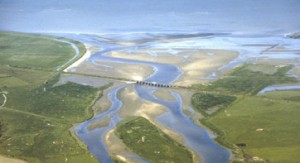
The extensive mud flats of the Roe Estuary are exposed at low tide and hiding just below the surface is a banquet of small seashore animals such as lugworm, shrimps, ragworm and periwinkles. There are also large beds of mussels and extensive areas covered in eel grass. All of which are the food that attracts many thousands of migrating waders, ducks, swans and geese that stop over on Lough Foyle every winter.
Inside the railway bridge is an area of saltmarsh, managed as a nature reserve by Northern Ireland Environment Agency. Here in the spring you can watch lapwing aerial displays, and hear the haunting calls of the curlew. The River Roe and its tributaries is one of the most important rivers in the UK for Atlantic salmon.
Access and Facilities
To get the best view of the estuary on the outer side of the railway bridge it is recommended visitors use Myroe Level as described previously. To view the nature reserve turn off the Seacoast Rd (B69) at Crindle, follow the Carrowclare Rd to a T junction and turn right where you come to a small car park after a short distance. Around high tide you can get good views from the car park without causing too much disturbance to the flocks.
Starting point grid reference: IC645 290


